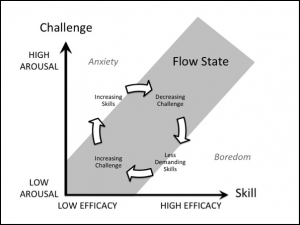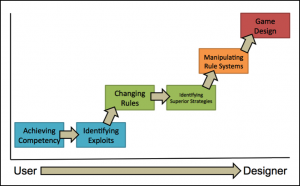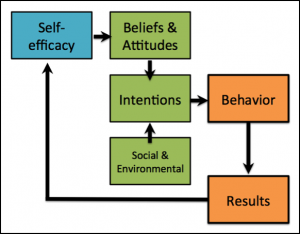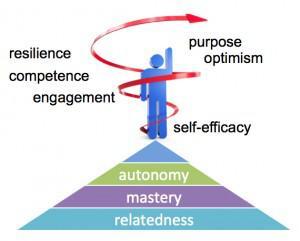 Many people have the image of video games as socially isolating, if not psychologically addicting. Yet, like my friend Kristin demonstrated when she joined her son in the online game Wizard101 (see part 1), video games can connect families and friends across time and distances.
Many people have the image of video games as socially isolating, if not psychologically addicting. Yet, like my friend Kristin demonstrated when she joined her son in the online game Wizard101 (see part 1), video games can connect families and friends across time and distances.
In my last post, The Positive Side of Video Games: Part II, I talked about how games are games function as learning environments. In this third, and final, post, I will talk about how games can facilitate positive emotions through connection and mastery.
DIWO (Do it With Others) or Quests with Friends
Unlike email, texting, or even a phone call, playing a game with someone creates a sense of actually doing something together. Games create a sense of presence — the sense of being in a shared space (Ijsselsteijn, Freeman, & De Ridder, 2001). Beyond the affinity groups (Gee, 2007). and communities of learning (Lave & Wenger, 1990), games can provide a virtual location for social interaction and relationships beyond home or work because game environments function as Oldenburg’s (1999) “third spaces” or “great good places,” the informal places such as parks and coffee shops that encourage easy sociability and community (e.g., Steinkuehler & Williams, 2006). Multi-player games can be extremely social, with a high percentage of players making lifelong friends and partners (e.g., Cole & Griffiths, 2007).
Optimal Engagement in Flow
Csikszentmihalyi’s (1991) theory of Flow, or optimal engagement, is one of the most prominent concepts of Positive Psychology embraced by game developers (Pavlas, 2010). Several factors contribute to an individual achieving a Flow state. In the context of game development, the most notable is the balance between challenge and skill that allows an individual to be in and maintain the level of engagement defined as Flow (see figure below). The skill-challenge balance keeps emotions regulated in a productive way—it allows a player to be challenged enough to avoid boredom and not so much as to trigger anxiety. We can also map this to neuroscience in terms of arousal and the emotions that influence attention, such as conflict, complexity, novelty, and uncertainty or mystery (Rutledge, 2012).
There are other factors that contribute to Flow will sound familiar in the context of video gameplay. These include:
- The integration of clear goals with responsive feedback
- The merging of action and awareness so that the player has complete, focused concentration on the task at hand accompanied by a loss of self-awareness and the passage of time
- The sense of control and confidence

Figure 1. Balancing Challenge and Skill
Flow Paths
Flow is a description of experienced engagement in an activity over time rather than at a single point. The Flow channel represent the player’s experience path of continual interaction between challenge and learning. In well designed games, players perform at the edge of their competency guided by clear goals and feedback. In the Flow state, the experience of play is fluid and is intrinsically psychologically rewarding independent of scores or in-game successes (Csikszentmihalyi, 1991).
Flow and Learning Zones
The balance of skill and challenge keeps the player’s brain aroused, attention engaged and motivation high. The acquisition of skills to meet each challenge also provides a series of mastery experiences.
Games are designed with structures that create what Vygotsky (1978) called ‘zones of proximal development.’ where learning occurs due to observation and interactions that pull the player forward into more complex and demanding tasks.
Scaffolding is another key concept in Vygotsky’s model of social development. Scaffolding is the on-demand support that allows people to bridge the gap between current and required skills. The responsive feedback in gameplay along with social collaboration and communities provide this scaffolding, facilitating problem-solving and learning retention (Sun, Wang, & Chan, 2011).
A key feature of gameplay is that failure is not ‘failure’ in the schoolyard sense. Failure is equivalent to feedback and the risk of failing is minimal and recovery is easily achieved, encouraging exploration, experimentation and the development of new problem-solving strategies. The process of learning is a socially accepted progression providing social status through achievement in a peer-valued skill and allowing player to capitalize on their strengths.
Learning Trajectory
Community creates socially sanctioned support for curiosity and the motivation for scientific inquiry. Gamers frequently transform design issues into empirical questions, collecting data, building and comparing models to predict the system (i.e. decision rules, such as minimaxing or attempting to minimize the possible worst case or maximum loss) (Squire, 2008).

Figure 2. Trajectory of Player Experience
Consumption stimulates mastery and motivates production. The figure to the left shows Squire’s (2008) Trajectory of Player Experience which illustrates the gradual shift from player to designer, blurring the distinction between them similar to what we see happening to the boundaries between consumers and producers of other types of media, as well as breaking down of finite channels of distribution of media content.
Like Squire (2008), Salen and Zimmerman (2004) found that committed players change the rules for their own enjoyment, exploring which rules work and which don’t, and studying the structure that is contributing to meaningful game experience. The exploration becomes an iterative process of breaking, tweaking and modifying where players become more like designers or actually become designers.
Flow or Success
Whether a gaming experience creates a sense of control and competence from a Flow state, connection with an ideal self through immersion, or a sense of accomplishment or ‘fiero’ through skill mastery, these are positive emotions that have longer-term ramifications.
ADHD and learning-challenged children often experience more failures than others, especially in school. Failure, like mastery, impacts perceptions of self-efficacy and both build on previous experience to project future action, as illustrated in the schematic below.

Conclusion
The experience my friend Kristin had with her son in Wizard 101 (see part 1) is a good example of how we can reevaluate and reframe our understanding of games as avenues to develop mastery experiences that promote self-efficacy and positive emotions. In a video game, we can:
- Experience emotional and physiological arousal that focuses our attention
- Trigger intrinsic motivation through evidence of accomplishments and successes
- Observe modeled behaviors and receive mentoring through collaboration
- Establish meaningful social connections in communities of play
- Imagine ourselves in new ways with new strengths
- Practice problem-solving and behaviors in low risk environments

—
Cross-posted on Psychology Today Positively Media.
References
Cole, H., & Griffiths, M. (2007). Social Interactions in Massively Multiplayer Online Role-Playing Gamers. CyberPsychology & Behavior, 10(4), 575-583.
Csikszentmihalyi, M. (1991). Flow: The Psychology of Optimal Experience. New York: HarperCollins Publishers.
Fredrickson, B. L. (2004). The broaden-and-build theory of positive emotions. Phil. Trans. Royal Society London, 359, 1367-1377. Retrieved from
Garland, E., Fredrickson, B. L., Kring, A. M., Johnson, D. P., Meyer, P. S., & Penn, D. L. (2010). Upward spirals of positive emotions counter downward spirals of negativity: Insights from the broaden-and-build theory and affective neuroscience on the treatment of emotion dysfunctions and deficits in psychopathology. Clinical Psychology Review, 30(7), 849-864.
Gee, J. P. (2007). What Video Games Have to Teach Us About Learning and Literacy (Revised & Updated) (2nd ed.). New York: Palgrave Macmillan.
Ijsselsteijn, W. A., Freeman, J., & De Ridder, H. (2001). Presence: Where Are We? CyberPsychology & Behavior, 4(2), 179-182. Retrieved from http://search.ebscohost.com/login.aspx?direct=true&db=aph&AN=5323497&site=ehost-live
Lave, J., & Wenger, E. (1990). Situated Learning: Legitimate Peripheral Participation IRL Report (Vol. 90-0013). Palo Alto, CA: Institute for Research on Learning.
Oldenburg, R. (1999). The Great Good Place: Cafe´s, Coffee Shops, Community Centers, Beauty Parlors, General Stores, Bars, Hangouts, and How They Get You Through The Day. New York: Marlowe & Company.
Pavlas, D. (2010). A Model of Flow and Play in Game-based Learning: The Impact of Game Characteristics, Player Traits, and Player States. (PhD Dissertation), University of Central Florida, Orlando, FL.
Rutledge, P. B. (2012). Augmented Reality: Brain-based Persuasion Model. Paper presented at the 2012 EEE International Conference on e-Learning, e-Business, Enterprise Information Systems, and e-Government, Las Vegas, NV.
Salen, K., & Zimmerman, E. (2004). Rules of Play: Game Design Fundamentals. Cambridge, MA: The MIT Press.
Squire, K. R. (2008). Open-Ended Video Games: A Model for Developing Learning. In K. Salen (Ed.), The Ecology of Games: Connecting Youth , Games, and Learning (pp. 167-198). Cambridge. MA: MIT.
Steinkuehler, C., & Williams, D. (2006). Where Everybody Knows Your (Screen) Name: Online Games as “Third Places”. Journal of Computer Mediated Communication, 11(4). Retrieved from http://jcmc.indiana.edu/vol11/issue4/steinkuehler.html
Sun, C.-T., Wang, D.-Y., & Chan, H.-L. (2011). How digital scaffolds in games direct problem-solving behaviors. Computers & Education, 57(3), 2118-2125. doi: 10.1016/j.compedu.2011.05.022
Tugade, M., & Fredrickson, B. L. (2004). Resilient Individuals Use Positive Emotions to Bounce Back From Negative Emotional Experiences. Journal of Personality and Social Psychology, 86(2), 320-333. Retrieved from
Vygotsky, L. S. (1978). Mind in Society. In M. Cole, V. John-Steiner, S. Scribner & E. Souberman (Eds.). Cambridge, MA: Harvard University Press.


posted on 27 February at 19:15
Researching flow state & 'the Hedonic-Motivation System Adoption Model (HMSAM)' & I found your post! nice! it's been a LONG time since we connected!